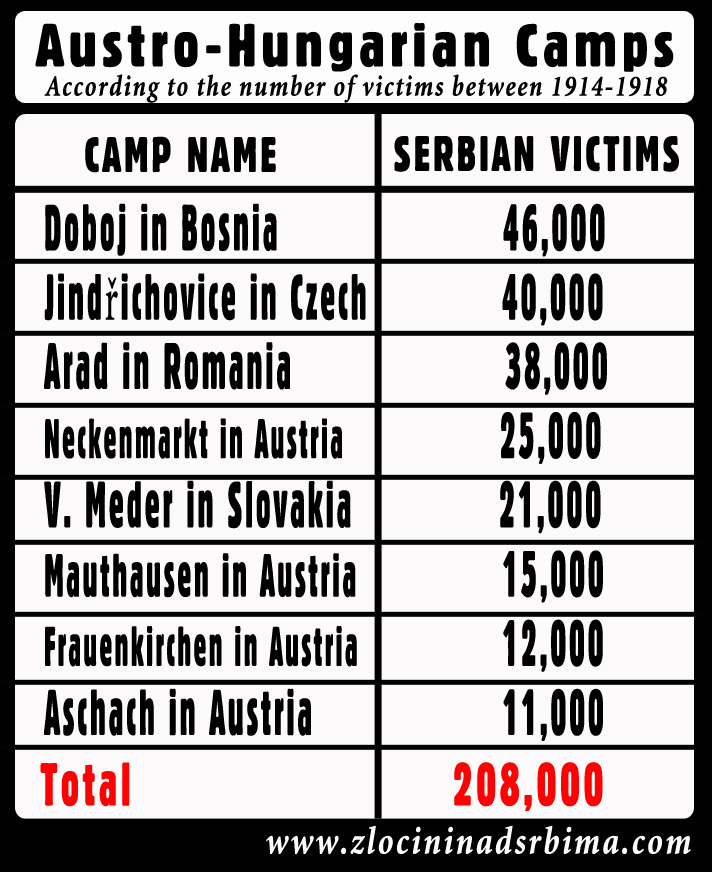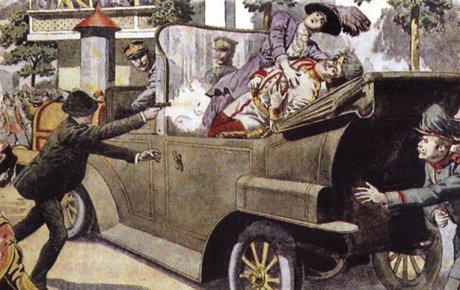|
|
Period:
First World War
Region:
Austro-Hungary
The Austro-Hungarian camp in Sopronnyék 1915
The Sopronnyék concentration camp is one of the many Austro-Hungarian camps established during World War I, where thousands of Serbs were imprisoned, but other nations at war with the Habsburg monarchy, as well (Italians, Russians…).
This camp was located under the Neusiedl lake in the Burgenland district of Austria, 75km (46 miles) south of Vienna or 500 km (311 miles) south-east of Belgrade.
The Sopronnyék camp was established under the instruction of the military authorities of Austro-Hungary on 5th April 1915, which most of the high officials of the government, parliament and the royal palace were quite familiar with, and it existed until mid-November of 1918.

Between 25,000 and 30,000 Serbs were imprisoned in this dungeon of death, and around 8,000 Serbian soldiers and civilians perished, which represents a genocidal plan of Austro-Hungary against Orthodox Serbs. In total, around 40,000 people went through this camp for three and a half years of its existence.
After World War I, a modest monument was placed to testify on the horrors of that time when dozens of prisoners died daily, mainly due to the cold, hunger, and sickness.
|
FIRST WORLD WAR 1914-1918 |
|
Battles of: Cer, Drina, Kolubara, Leget, Cemerno, Mojkovac, Kajmakcalan, Gornicevo, Dobro Polje
Camps: Mauthausen, Arad, Jindrihovice, Broumov, Boldogasonj, Nadjimer, Nezider, Aschah, Doboj, Sliven
Crimes: Macva, Surdulica, Great Retreat, Sabac
|
BACKGROUND
At the beginning of 1904, the Kingdom of Serbia signed a trade agreement with the USA, France and Russia... and began exporting its products to the overseas countries through the port of Thessaloniki.
This led to a great economic upswing of the Kingdom of Serbia, which annoyed the Vienna Court, which viewed Serbia as a great rival since Serbia had the highest economic growth rate in Europe at the time, and at the same time a large number of Serbs lived in the occupied territories of the Habsburg Monarchy.

Map of south-eastern Europe in November 1913.
The army of the Kingdom of Serbia liberated its enslaved territories (Raska, Kosovo and Metohija and Old Serbia) from the Turks in the First Balkan War, by achieving major victories in the fall of 1912 at the command of Duke Petar Bojovic at Kumanovo, Prilep and Bitola, and as such completely expelled the Ottomans from the Balkans.
And a year later in the summer of 1913 the army of the Kingdom of Serbia protected Vardar Macedonia from the Bulgarians in the Second Balkan War. The Serbian national revolution was thus continued, at the beginning of the 19th century by Karadjordje Petrovic and Milos Obrenovic.
In the summer of 1914, the Austro-Hungarian Monarchy used the Sarajevo assassination, that is, the assassination of Austrian Crown Prince Franz Ferdinand by members of Young Bosnia (Gavrilo Princip, Bogdan Zerajic, etc.) as an excuse to invade the Kingdom of Serbia, thus starting First World War.

Gavrilo Princip and his comrades in Sarajevo
A dispatch was sent from Vienna, which no sovereign state could accept. Thus, in late July 1914, Austria-Hungary declared war on Serbia. Montenegrin King Nikola I Petrovic and Russian Emperor Nikolai II Romanov immediately sent messages saying that they would help the Serbs. Likewise, German Emperor William II made a military alliance with the Vienna Palace.
ESTABLISHMENT
The Sopronnyék camp was established on 5th April 1915 under the instruction of military high command in Pozhun (near Bratislava) on a hill 12 km away from the village Sopronnyék. This village was then a part of Austro-Hungary, hence that name, today it is a part of Austria and it is renamed to Neckenmarkt.
The village of Sopronnyék or Neckenmarkt is located 75km south of Vienna in the Austrian district Burgenland, the municipality of Oberpullendorf in the vicinity of Neusiedl lake, that is 215 km west of Budapest and 500km north-east of Belgrade.
Realizing that concentration camps in Hungary were filled beyond the permitted capacity, the decision was made to construct a new camp, hence these dungeons were in Sopronnyék. The camp was expected to hold 15,000 detainees.
Prisoners were brought to the Sopronnyék camp by cattle wagons, mostly Serbs from territories of Bosnia and Herzegovina, Dalmatia, Slavonia, Srem, Šumadija, Podrinje, Raška, Dragačevac area, Montenegro, Pomoravlje, but also Italian soldiers from Tyrol Italy, soldiers of the Russian Empire and the Kingdom of Romania.
Serbs in this dungeon of death were more civilians than soldiers, mostly transferred from the camp of Doboj in Bosnia. Mostly women and children from Podrinje and Herzegovina were sent to Sopronnyék where many died from exhaustion and suffering.
At one point, there were around 8,000 Serbs imprisoned, of which 250 children younger than 15.
CAMP CONDITIONS
In the beginning, the Sopronnyék camp was constructed to include 70 large cottages where the inmates were housed, but later this number reached 500 cottages. A small portion of those cottages was intended for inmate medical care.
In comparison to other Austro-Hungarian camps, this one had a higher level of medical care for the inmates. Even hygienic status was better here than in other dungeons of the black and yellow monarchy.
Winters were very cold so that mercury in the thermometer was as low as astonishing -25’C, and the conditions were further worsened by winds from the Alps. Most of the inmates died of cold, actually diseases aggravated by the cold.
Prisoners in Sopronnyék were forced to work physically intensive labor under strict guard, mostly on agricultural estates.
CLOSURE
The Sopronnyék camp was closed on 13th November 1918, upon the end of World War I, when Austro-Hungary was disintegrated.
At that time, inmates travelled by trains to their homeland reaching their homes several months later.

YEARS LATER
On the spot of the former camp, several crosses were placed along with a small monument, which all stand witness to the hardships and sufferings that occurred there in the early 20th century. The monument was erected mostly thanks to Italian citizens who wanted to mark the place of their murdered compatriots.
Victims of the Sopronnyék camp were buried throughout entire today’s Hungary, at 114 locations according to some estimates.
Today, this place of the former camp is visited by the Serbian community in Austria.
Tags:
Please, vote for this article:
Visited: 1089 point
Number of votes: 5
|